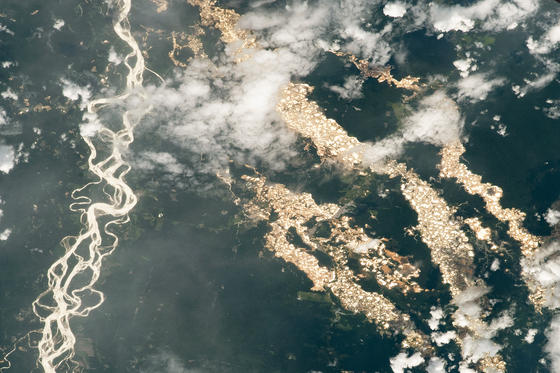![The Amazon rainforest region of Madre de Dios in southeastern Peru, photographed by an astronaut at the International Space Station (ISS). Numerous puddles that were sold for gold mining are shining reflecting in the sunlight. [사진 NASA]](https://i0.wp.com/pds.joins.com/news/component/htmlphoto_mmdata/202102/08/6483c77c-1e79-49c3-b5b5-83a74947ec52.jpg?w=560&ssl=1)
The Amazon rainforest region of Madre de Dios in southeastern Peru, photographed by an astronaut at the International Space Station (ISS). Numerous puddles that were sold for gold mining are shining reflecting in the sunlight. [사진 NASA]
Numerous golden pools devastating the dense forest. Small water streams from the puddle lead to a river that flows next to it. This is the Amazon rainforest seen from space.
NASA unveils satellite imagery of illegal gold mine
Rainforest turns into polluted lakes
Release after using mercury to separate gold
Amazon river dolphins are also endangered
The NASA released a satellite image of the Amazon rainforest severely destroyed by illegal gold mining in the state of Madre de Dios in southeastern Peru. This is a picture taken by an astronaut on the International Space Station (ISS) on December 24 last year.
These pools are illegal mining sites that were cut down and sold by independent miners to dig gold. After digging a 3-4m pit to find gold ore, water is filled, and the numerous puddles created in this way shine brightly as the sunlight reflects.
![Peruvian Amazonian rainforests devastated by illegal gold mining. [EPA=연합뉴스]](https://i0.wp.com/pds.joins.com/news/component/htmlphoto_mmdata/202102/08/a9aebd46-a43a-4484-a577-74acb91e3fe7.jpg?w=560&ssl=1)
Peruvian Amazonian rainforests devastated by illegal gold mining. [EPA=연합뉴스]
Peru produces the sixth largest amount of gold in the world. The Madre de Dios region is considered the home of the world’s largest gold mining industry.
In this area alone, tens of thousands of people make a living from these unauthorized mines. Illegal gold mining on a small scale has turned lush rainforests into ponds and lakes covered with muddy water. The Peruvian government has mobilized the military and police to clear out illegal gold mines, but it has failed to achieve great results due to the collusion between criminal organizations and local residents and sharing information with each other.
The problem is that this illegal mining is not only a major cause of deforestation in the Amazon, but also causes severe mercury pollution in the process of extracting gold.
![Peruvian miners using basins and mercury to extract gold. [AP=연합뉴스]](https://i0.wp.com/pds.joins.com/news/component/htmlphoto_mmdata/202102/08/ffc826d7-78a0-408b-9f52-527077a24794.jpg?w=560&ssl=1)
Peruvian miners using basins and mercury to extract gold. [AP=연합뉴스]
Small illegal mining sites spray gold ore with mercury to separate the gold. Thereafter, the water containing mercury is flowed out without a separate purification process. Because of this, the Amazon region has been continuously destroyed by forests and contaminated with mercury and other chemicals.
Jacqueline Gus’s research team at Duke University analyzed the composition of water and sediment samples from lakes and rivers along with analysis of landscape changes in Madre de Dios from 1985 to 2018. As a result, it was revealed that the area of artificial lakes in areas where unauthorized mines were concentrated increased by 6.7 times in 33 years.
![Tucush dolphins living in the Amazon River area are endangered due to water pollution caused by illegal mining. It is estimated that there are only 30,000 dolphins living in the Amazon River basin. [로이터=연합뉴스]](https://i0.wp.com/pds.joins.com/news/component/htmlphoto_mmdata/202102/08/c3f2c073-cfc3-4c1a-b2de-32184802962a.jpg?w=560&ssl=1)
Tucush dolphins living in the Amazon River area are endangered due to water pollution caused by illegal mining. It is estimated that there are only 30,000 dolphins living in the Amazon River basin. [로이터=연합뉴스]
“In lake water (made by gold mining), mercury is converted to methylmercury, which is harmful to humans at a rate of 5 to 7 times higher than that of rivers.” “Small gold mines greatly increase the risk of mercury exposure to humans and wildlife. It suggests that it is being done.”
In fact, due to water pollution, the threat of extinction of freshwater dolphins living in the Amazon River is gradually increasing. Among the dolphins living in the Amazon River, the Tukushi dolphin, known as the “little dolphin,” rose from “Vulnerable” to “Endangered” on the International Union for Conservation of Nature (IUCN) endangered species list in December last year. It means that it is at a very high risk of extinction in the wild.

Peru
The Colombian environmental group Omacha Foundation explained that water pollution from unauthorized gold mines and the construction of a hydroelectric power plant threaten the ecology of Tucusi. Previously, the pink dolphin inhabiting the Amazon River was also designated as a’critical’ species by IUCN two years ago. It is estimated that there are only 30,000 dolphins living in the Amazon River basin.
In an interview with Reuters, Omacha Foundation biologist Fernando Trujillo told Reuters that “the number is small given the size of Amazon,” and “if not taken, it could disappear within 20 to 30 years.”
Reporter Chun Kwon-pil [email protected]
